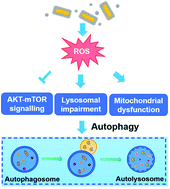Initiation of protective autophagy in hepatocytes by gold nanorod core/silver shell nanostructures†
Abstract
The high reactivity of silver nanoparticles leads to their broad applications in the anti-bacterial field; however, the safety of silver nanoparticles has attracted increasing public attention. After exposure to silver nanoparticles in vivo, the liver serves as their potential deposition site; however the potential biological effects of such nanoparticles on hepatocytes at low dosages are not well understood. Here, we study the interaction between gold nanorod core/silver shell nanostructures (Au@Ag NRs) and human hepatocytes, HepG2 cells, and determine that Au@Ag NRs at sub-lethal doses can induce autophagy. After uptake, Au@Ag NRs mainly localize in the lysosomes where they release silver ions and promote the production of reactive oxygen species (ROS). The ROS then suppress the AKT-mTOR signaling pathway and activate autophagy. In addition, oxidative stress results in lysosomal impairment, causing decreased ability for lysosomal digestion. Moreover, oxidative stress also affects the structure and function of mitochondria, leading to the initiation of protective autophagy to eliminate the damaged mitochondrion. Our study shows that at sub-lethal dosages, silver nanomaterials may alter the physiological functions of hepatic cells by activating protective autophagy and cause potential health risks, indicating that cautious consideration of the safety of nanomaterials for certain applications is necessary.

- This article is part of the themed collection: Research selection from the NCNST


 Please wait while we load your content...
Please wait while we load your content...